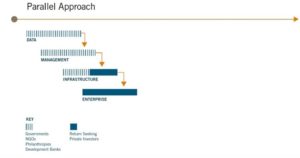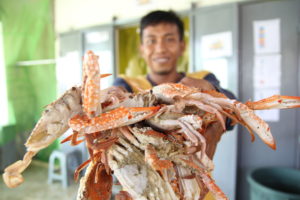Leverage the Middle for Improved Fishery Management and Revenue
The New Middleman: Service Provider and Quality Assure
“Middle man — the very term itself is associated with extra hoops to jump through, farmers being cheated, and limited value being offered to farmers and value chains generally. The idea of cutting out the middle man is frequently thought of as a selling point, casting these intermediaries as the “bad guys” of the value chain, worth avoiding whenever possible.” -Robert Anyang, Chemonics
Reading this recently on the Agrilinks blog, I subconsciously substituted “fisher” for “farmer” because the same is true for our marine resources. Our friends at Smartfish, in Mexico, led us to imagine how a “good middleman” could lead to a more equitable distribution of money along the value chain, i.e., greater social impact, while also promoting fishery health, i.e., environmental impact.

Parallel Approach to Fisheries Development
At Wilderness Markets, we believe that middlemen, whether they are called intermediaries, buyers, or agents, can provide a vital link in low governance fisheries. (We consider simultaneous governance and value chain development in emerging markets as a “parallel approach” to fisheries. You can read more about this here and here.) Processors and distributors committed to promoting responsible fishing can employ “good middlemen”. These can provide services and also act as service providers and informal fishing rules enforcers in geographies where official government management is lacking.
The Current Role of Middlemen (and Women)
Often viewed as part of the problem, in many instances independent middle buyers often take on a great amount of risk in the value chain. By paying cash for goods, they then take responsibility for ensuring they’re able to make a profit. This may require days of transport, during which any delays or excess heat cause spoilage and loss of value. They also take on the burden of finding the best paying buyer. In Indonesian tuna, snapper and swimming crab value chains, middle buyers also forward cash and supplies to the fishermen they purchase from.
Yes, some middle buyers take advantage of the harvesters they buy from – charging exorbitant interest, or not paying a fair amount for the product. This is an opportunity for competitors.
Better Use of Resources: The Role of Intermediaries in Parallel Development
Smart end buyers have started taking advantage of these vacuums as opportunities to assure quality, but this could be leveraged even more. So far we’ve seen a processor in Indonesia who keeps local middle buyer on their payroll; the community knows and trusts her, and she targets the best quality tunas. She pays well and in-cash; however, she does not let the community know she’s actually working on behalf of the processor because they fear the community may either not want to sell to her or may expect higher prices.
In Indonesia, fisheries are generally data poor and enforcement of regulations, if they exist, is lax in most fisheries. As is common, the fishing industry is as or more developed than fishery management. This situation is prime for parallel development, whereby industry, government, NGOs, and philanthropy work together to promote sustainable development of the fishery so that fishers can continue to harvest but not to the detriment of successive generations.
Localized data collection and management are increasingly popular ideas and are of great interest in the blue swimming crab (BSC) fisheries where exporters are trying to avoid overfishing due to its high costs, like smaller and fewer crabs, that may force companies to eventually relocate their operations. Efforts like this is one of the ways to increase enforcement in locations where the government has difficulty doing so. Middle buyers working on behalf of companies affiliated with exporters can promote responsible fishing is by not buying undersize or actively reproducing females.

Sumatran Fisherman with Blue Swimming Crabs
Using the Middle for Management
We recently worked with one US importer of Indonesian BSC (about 80% of Indonesian BSC is exported to the US) to create a mobile app that allows the picking plants, who are a first or second level “middleman”, to keep track of landings data, including size, fishing grounds, and weight. Among the benefits are the ability to avoid areas with undersize crabs and egg-bearing females. As both have lower quality meat, it means that not only are the plants more able to avoid this lower quality crab, but also that the crab population has more of an opportunity to regenerate. A win for the plants, the fishers (who can make more money) and the environment.
Working together to promote smarter management produces benefits for fishers and the environment which improves stability of the resource for the importers. Companies can gain more agency over the product quality as well as improve fishery management by employing middlemen as agents and intermediaries.
Subscribe or send us an email to stay updated on our work—both options are below.



